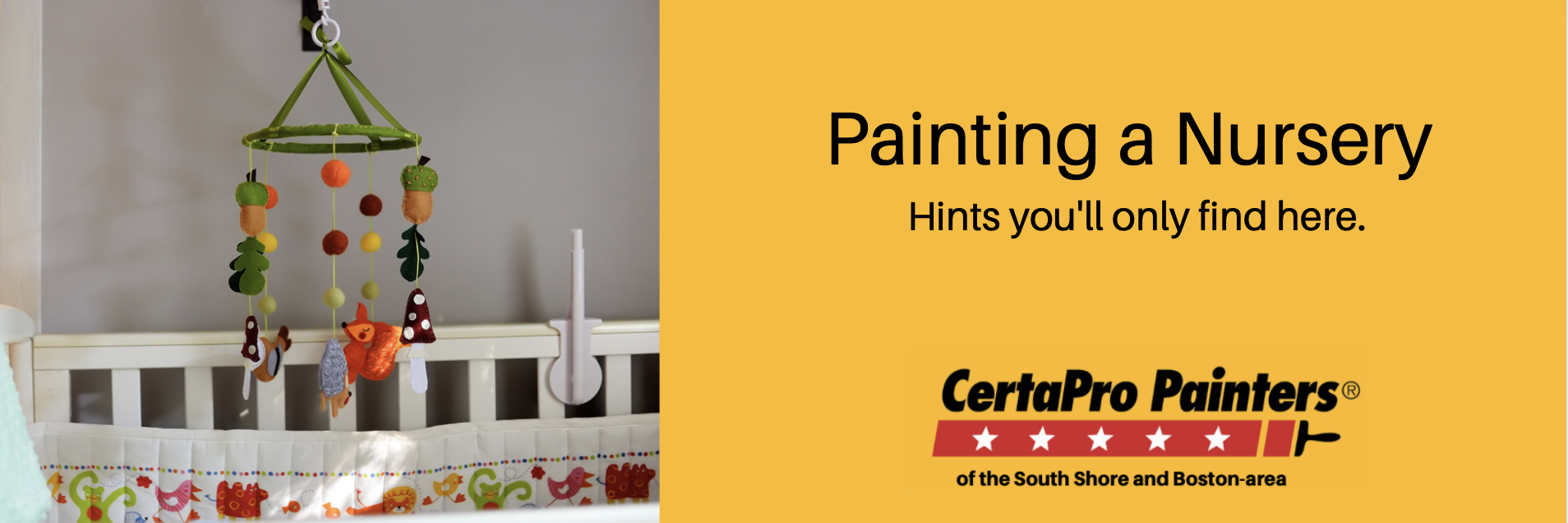
Choosing the perfect nursery color – tips you haven’t read before.
Posted on October 13, 2022
In the weeks before your baby is born, you’ll likely spend time deciding what color to paint the baby’s nursery. Here’s some practical advice, based on our experience painting the nurseries in dozens of South Shore homes since 1998.
Finding your inspiration.
When deciding what color scheme you would like to use in your baby’s nursery, consider the room’s other elements first:
Decorating in the right order means:
- Choosing fabrics, carpet, and drapery first
- Matching the paint to the fabrics in #1.
Why is this decorating order important? Paints can be matched to any fabric. But the opposite is not always true – if you fall in love with a paint color first, you might have difficulty finding matching fabrics. We tell our clients that decorating in the right order makes paint color choices so much easier.
Name the feeling you want to achieve in the nursery:
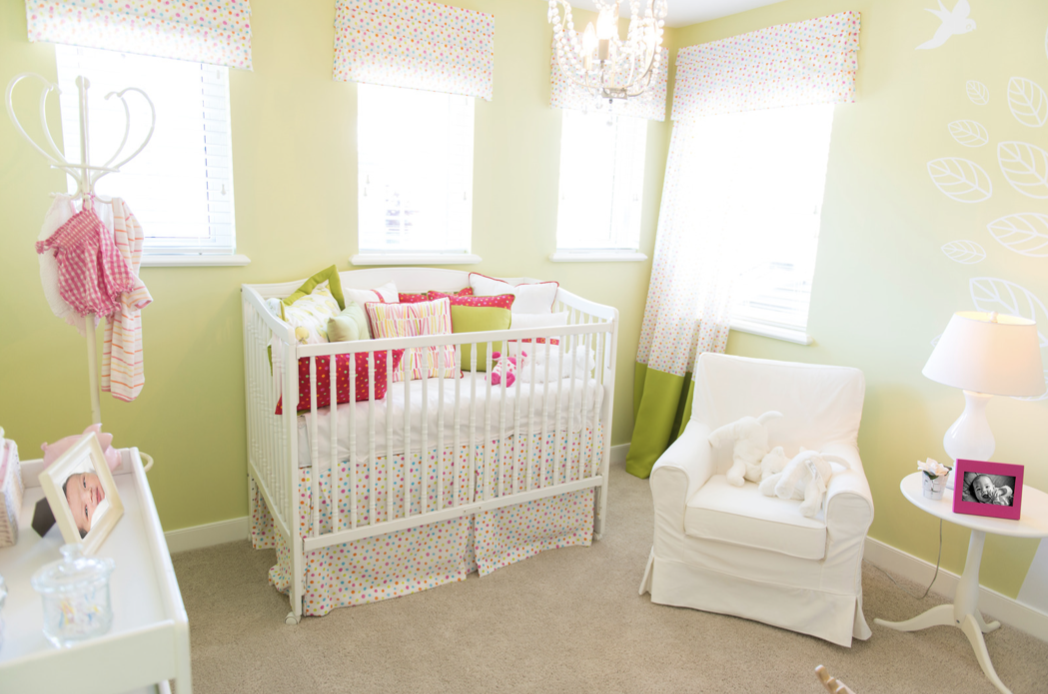
Finding your inspiration is easier if you think ahead to the environment you’re trying to create. For example you might want a gender-neutral nursery or one that grows up with your child.
Or maybe you have a specific fabric color and pattern in mind that you need to which you’ll match the paint.
Above all else, try naming the feeling you want to achieve in the room before deciding on a color scheme.
Whether you want your baby’s nursery to be a bold energizing space or a more muted and calm, paint color can achieve this if you name your goal for the room’s feeling at the beginning of the project.
Some “words” to consider when choosing the feeling you want in the baby’s room:
- Energizing
- Calming
- Sophisticated
- Dark (no, dark is not a feeling, but it encourages better sleep, so you and your baby feel better!)
Popular colors for a baby’s nursery:
The following colors are just starting points; clicking on the paint color links will show you the color painted in a room. Use these pigments as starting points to choose colors and move lighter or darker to see if you can find a color that fits the mood you’re trying to create.
Silver Blue: A classic for boys, but easily gender-neutral too. Start with Sherwin Williams’ Upward to start and see how it looks in your lighting.
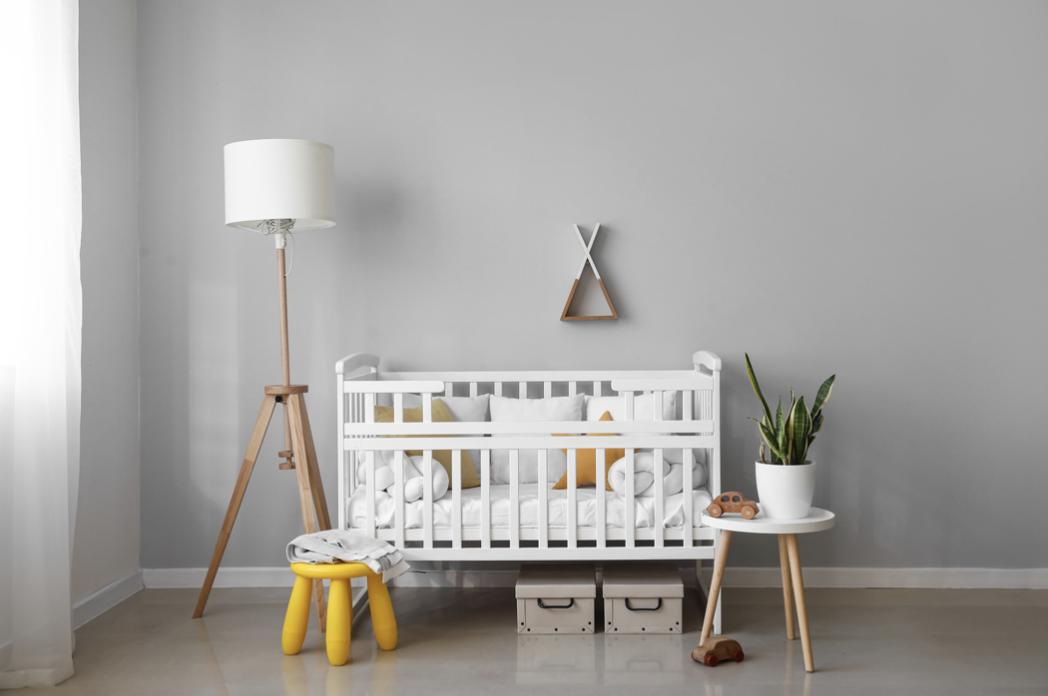
Gray: Gender neutral and on-trend. Modern and fresh. Sophisticated. Sherwin Williams’ Reflection is a medium gray with which to start your sampling.
Greige: A mixture of beige and gray. Gender neutral and calming. A long-term choice as it is not babyish so it will grow with your child. Try Repose Gray by Sherwin Williams as inspiration.
Butter yellow: Calming and optimistic at the same time. Sherwin Williams’ Full Moon is not babyish or overwhelming. We also like Benjamin Moore’s Vellum as a starting point.
Understand that the right yellow is probably the most difficult color to get right. What looks like an innocent yellow on the color chip often feels overwhelming once it’s painted in the entire room. Lighting plays a big factor in yellows as well. Working with our free designer in your space is encouraged, especially for choosing yellows.
Antique pink: Feminine and mellow. Aim for a pink that’s a bit muted with brownish undertones, so it will grow up with your child. The last thing you will want to spend money on amid diapers and preschool fees is repainting the room, so think long-term. Abalone Shell by Sherwin Williams and Benjamin Moore Magic Potion are pinks that aren’t “too sweet.”
Sage green: Be careful that there’s not too much brown in this gender-neutral color; otherwise, it can look dingy. The perfect sage, though, can grow with your child for years. See if Sherwin Williams’ Liveable Green or Benjamin Moore’s Louisberg Green works in your lighting and adjust from there.
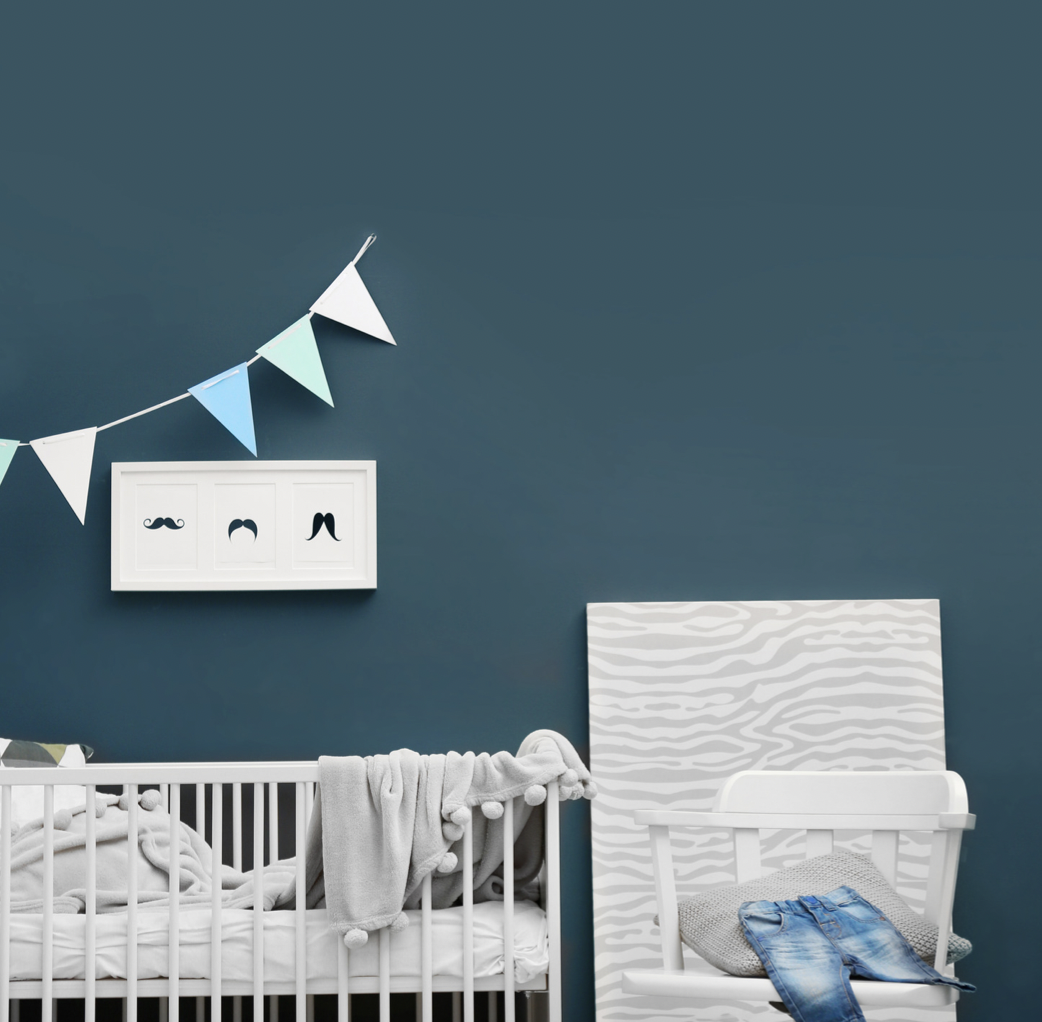
Dark paint colors: Many South Shore painting clients have decided to use darker versions of the above colors to keep the room as dark as possible (and keep the baby sleeping as long as possible). Pair with room darkening shades for the full effect.
Consider how the paint color will look in an older child’s room:
The nursery will also likely be your child’s bedroom as they age. And the last thing you may want to do is repaint the room at every stage of childhood. So remember how the color will age as your child grows up.
Will that light pink or yellow suit an older child?
Going neutral may be the best way forward, so you’re not spending money to repaint when you could put that money in their 529 plan. A neutral nursery also makes way for subsequent babies in your home, while the older child moves to a larger room.
What color should I paint the nursery ceiling?

Infants spend much time on their backs, staring up at the ceiling.
While leaving the ceiling white is the most common choice, painting the ceiling a contrasting color looks fantastic.
Recently, we painted a nursery with pink walls with a butter-yellow ceiling – it looked designed and modern.
Our free color consultant can help you choose the perfect wall and ceiling color for your baby’s nursery.
Cool versus warm paint colors:
Once you have decided on fabrics and furniture for your baby’s room, it’s time to pick the perfect color for the walls. Depending on the amount of light that will be entering your baby’s room, you’ll want to choose either a warm or cool color. Warmer colors generally look better with lower light, and cooler colors look better with brighter light.
Always test colors at different times of day, as paint colors look very different in the morning than in the evening. In our experience, we’ve had clients change their minds about colors after noticing how dingy they look at night with no light streaming through the windows. Work this out by sampling many colors with large swaths of paint and checking them morning and night before making your final choice.
We offer free 8″ x 10″ paint samples, mailed right to your home, even if you’re doing the painting yourself. Just email Paige at [email protected] with some Sherwin Williams or Benjamin Moore colors, and we’ll send them to you. This way, you don’t have to sample messy paint.
Here are our instructions on sampling paint based on our experience painting thousands of interior South Shore rooms.
Use washable paint:
It’s a baby’s room, after all.
Look for words like “scrubbable” and “washable” on the paint’s label.
Lighting is key when choosing a paint color?
If you’re spending a lot of time in your baby’s room, you need to ensure that it is a space that makes you (the parent) feel comfortable and relaxed. The lighting in your baby’s room will be a huge part of helping you achieve this. Plus, sleep experts recommend keeping the nursery as dark as possible.
There are a few ways to alter the way light is present in the nursery:
- Don’t just rely on overhead lights – add lamps. This is especially helpful next to the glider or seat and can be practical when reading to your child.
- Install a dimmer on your wall switch to set the mood before bedtime or check on a baby without waking them.
- Install blinds and curtains to block out light and help the baby nap during the daytime. If you’re lucky, it may give you a few precious minutes of sleep in the morning. If installing blackout roller shades, use curtains to fill the gaps on the side that will let in light.
- Use different light bulbs, including pink ones, to alter the mood and make it more relaxing for both the parents and the child.
By controlling the light entering your baby’s room, you’ll make it a much more relaxing and enjoyable place to be, and you might keep the baby sleeping longer.
Consider the paint sheen.
When choosing the nursery paint color, consider the paint sheen. Flat paints have no gloss and will seem lighter than glossy sheens. It is fun to put a piece of glossy mailing tape over a paint chip to see it go from light to dark before your eyes.
The sheen in wall paint can also cause glare. To keep the glare out of the nursery, find paint that has a low LRV or Light Reflective Value. The LRV is represented in numbers, and 60 or lower is the number to aim for (but no need to really go too crazy). You’ll find the LRV indicated on the paint’s label.
Aim to have the nursery completed a month ahead of your due date:
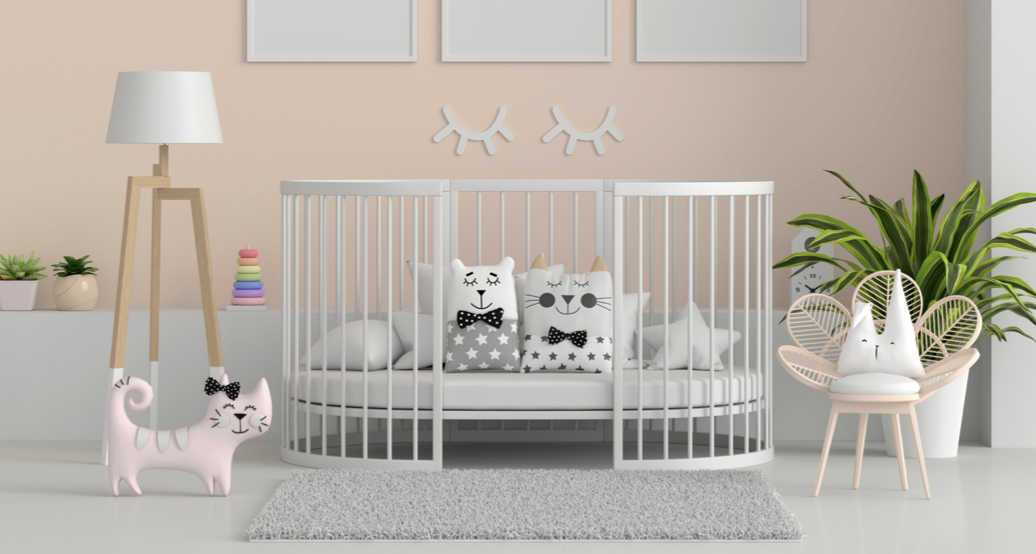 Assume your baby will be born before their due date, so the painting is completed before the baby’s arrival. The last thing you want to hassle with is a half-painted room during your first days with your baby.
Assume your baby will be born before their due date, so the painting is completed before the baby’s arrival. The last thing you want to hassle with is a half-painted room during your first days with your baby.
Starting early on all aspects of decorating is also a good idea if you’re choosing synthetic furnishings that will off-gas VOCs (see below).
Don’t go overboard decorating a baby’s room:
While adding details to the baby’s room, be sure not to overload the space with too much “stuff.”
As babies get older, their belongings naturally proliferate. Believe us, even if you start with an empty room on your child’s first day of life, it’ll be a “full” room a year later!
Also, remember that the decorations are largely missed on a baby. Save money by decorating with what you have.
Help, we’re renting, and I’m not allowed to paint the walls:
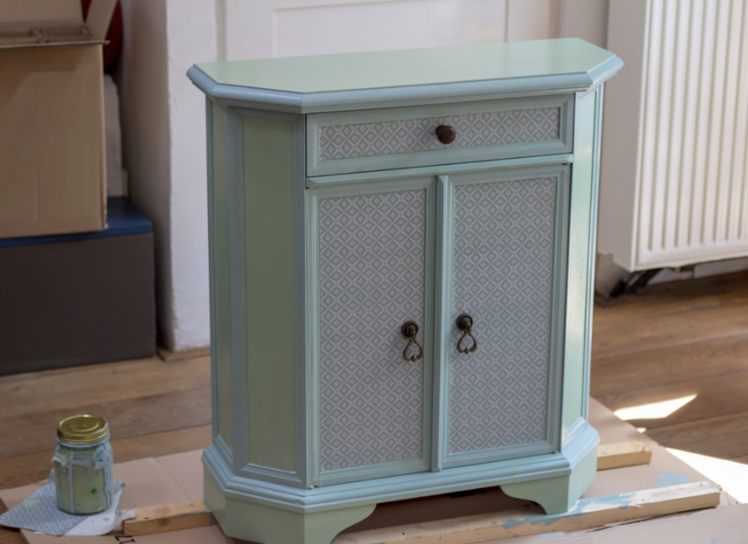
There are so many options for decorating a room without painting the walls:
- Consider removable wall decals or wallpaper. These are great options and look fantastic in a nursery.
- Paint the dresser and changing table to add color. However, we don’t recommend painting a crib since the baby could chew on the crib.
- Hang up a quilt or blankets to add cuteness and a sound barrier to your walls.
- Decorate with art: This could even mean framing your baby’s footprints or an older child’s preschool art.
- Choose colorful drapes and fabrics. These furnishings will likely travel with you to your next home, so choose fabrics you’ll love for years. In our experience, it’s common for furniture like overstuffed chairs to be handed down to other children and eventually end up in the finished basement during the teen years.
We can’t afford to hire a professional painter:
Painting a nursery is a project you can DIY. Here are our instructions on how to paint a room. You’ve got this!
Safety always: Paint nurseries with no-VOC paint.
Many paints contain large amounts of VOC (Volatile Organic Compounds), which are harmful to inhale. VOC’s are toxic ingredients that are emitted by solvents in paint and new furnishings. This is sometimes called “off-gassing” and occurs when you buy new furnishings or use paint with VOCs int the formulas. It may actually be safer for your baby to use hand-me-down furnishings that have already “off-gassed” many of their VOCs.
If you buy new furniture, carpet, fabrics, or mattresses, off-gas it in the garage before putting it into the baby’s room. You won’t get rid of all of the VOCs, but it’s better than allowing them to build up in the small nursery.
To keep these toxins away from your baby, always use paint that contains No-VOCs.
To be very clear, painting with a paint that contains VOCs is harmful to babies and pregnant women.
No-Voc paints are relatively easy to find and available in a wide variety of colors and include the following popular labels:
Benjamin Moore Eco-Spec paint & primer
Sherwin-Williams new ProMar® 200 Zero VOC Interior Latex
Many parents fall in love with Farrow & Ball’s limited but amazing palette of colors, and we completely understand. Because Farrow and Ball paints are not completely VOC-free, consider matching the color with a brand of paint that has No-VOCs. Farrow & Ball paint also scores low on washability, so they’re not ideal for a nursery where messes happen, and toys knock against the wall.
Store the extra paint in a safe place
Be sure NOT to store it in the baby’s closet, where they might find it when they become mobile.
You’ll want the extra paint for touch-ups because chips and dings to the paint will happen.
If your home was built before 1978, assume it has lead paint:
You can buy lead paint testing kits to be sure.
If the paint on the current walls isn’t chipping or peeling, it’s less likely to cause lead exposure, but even paint that seems intact can be a hazard. This is especially true of doors and windows that may kick up lead paint dust by the friction of opening and closing them.
Window sills containing lead are a hazard to mobile babies, who might chew on the sill as they pull up and look out the window.
Don’t sand paint that may contain lead, or attempt to remove it yourself. We’re licensed lead renovators and can help you paint the nursery safely.
What if your house has mold?
You’ll want to get the mold removed before the baby comes home. Mold is especially prevalent in older buildings and moist environments.
Be sure to carefully evaluate the exact process of mold abatement, as the off-gassing of mold-removing chemicals can harm your baby.





